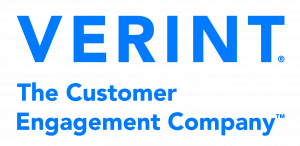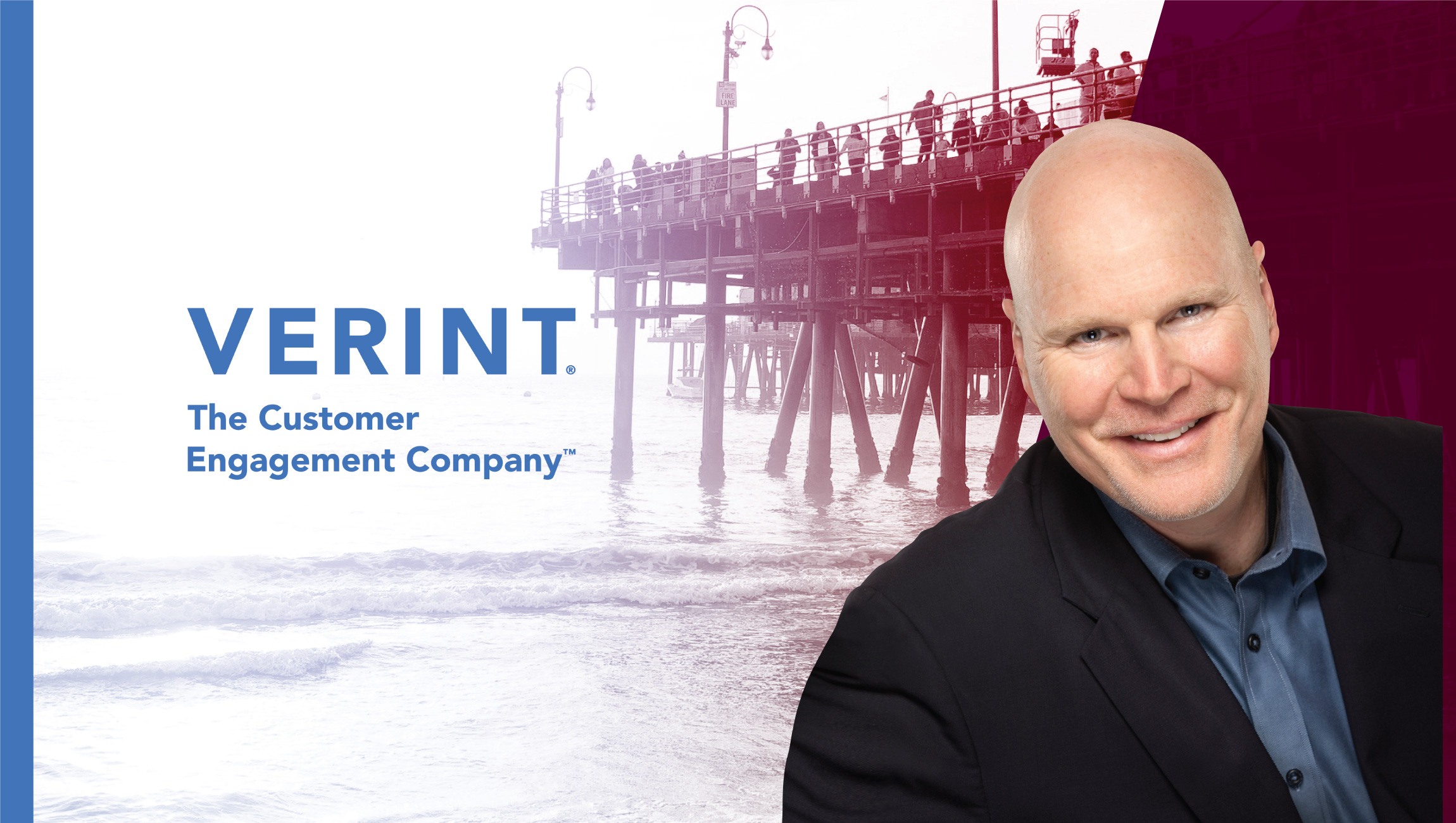[/vc_wp_text]
Tell us about your role and how you got here? What galvanized you to join a marketing technology company?
In my role as SVP of global marketing, I lead the more traditional marketing functions, but also get to step outside the box as executive sponsor for our customer experience program. Sales enablement is also part of our team, which is outside the realm of most typical marketing organizations. Having the opportunity to work with so many people at Verint who are pioneers and thought leaders in their respective areas of expertise—including Nancy Porte in CX and Kevin Strange in sales enablement—is one of the things that keeps me energized here. They are both dynamos. I love partnering with them to bring the principles of marketing to our CX effort and to help our salesforce deliver great results for customers through sales enablement.
In everything we do, including our standard functions of content marketing, communications, digital marketing and regional marketing, we focus on what I call the three P’s: Passion—market awareness and making sure our brand is well-known and understood; Pipeline—generating leads and campaigns to close them; and Productivity—delivering the right combination of tools and skills to enable our sellers to represent Verint and our offerings effectively.
How did I get here? I grew up in the San Francisco Bay Area—San Jose—and my dad was an engineer, so technology has always been part of my life. In college and the years that followed working with leading technology and marketing organizations, I knew the marketing side of technology was the right fit for me. The Verint acquisition of Witness Systems brought it all together—people with whom I had worked for years, including Nancy Treaster, now Verint’s senior vice president and general manager for strategic operations, joined another dream team of dynamos who were brilliant, diverse and innovative.
How is Verint different from other Customer Engagement platforms?
We’re focused on ROI and aligning new technology with the customer’s business values. While technology can often help in the achievement of financial goals, we always say that we’re customer first rather than technology first.
Always putting the customer first contributed to an overall evolution in the Verint business several years ago that created a culture called “Developing Customers for Life.” At Verint, it’s about how we view and treat our customers throughout their journey with us and serve as a trusted partner. We’re a customer-centric company with top commitment to success and really helping our customers gain maximum value from our customer engagement solutions.
What is the “State of Omnichannel Marketing” in 2018? How much of this state is influenced by the maturity of automation and 1:1 personalization tools?
For true omnichannel marketing to succeed, we need to create more personalized experiences across those channels. One thing has become clear: offering multiple communication channels is no longer a differentiator. It is table stakes that every organization should be minimally achieving. Omnichannel has evolved to the point that organizations must look beyond simply offering different ways to communicate.
If each of these communication channels is staffed with different employees using different tools and providing an inconsistent quality of service, then the channels don’t actually provide a benefit. Best-in-class organizations are seeking a unified strategy, with a unified view of the customer and centralized access to knowledge, data and processes.
How is mobile customer engagement different from when you first started? How do current analytics tools enable mobile marketers to outgrow their audience reach?
Mobile marketing has defined the past decade of customer engagement, but now we see the rise of voice interface and in-home assistants. While mobile marketing is still a valuable market, we’re always focused on what’s next, which is why we recommend our customers who truly want to grow their reach to invest in new technologies that align with their business goals and put them ahead of the crowd.
How do build an actionable customer interaction and communication model?
When thinking about customer interaction and communication, it all goes back to business intents. Each industry and company requires its own library of language and actions that the AI needs to understand. Since our technologies have been deployed to organizations for over 20 years, they leverage a huge library of business intents. This time and accumulation is crucial as each industry is unique—AI for financial institutions necessarily requires a different structure than healthcare, for example—and our library of intents allows us to drive customer interactions to be more than transactional. Once you have a real understanding of your customers’ needs through your intents model, that’s when you can achieve comprehensive communication that accomplishes task fulfillment and overall satisfaction.
Which startups in martech and adtech industries are you keenly following?
I’m on the board of advisors for a cool startup called SalesTing, which provides cutting-edge marketing and sales automation software powered by an AI engine. Like so many successful companies, it was incubated at Georgia Tech’s Advanced Technology Development Center. Its philosophy is that software has been linear for a long time. AI makes it intelligent and delivers higher value tied to business results—a philosophy that aligns perfectly with ours at Verint.
What marketing and sales automation technologies do you use?
Among many other tools, we use Eloqua for marketing campaign management, Demandbase for account-based marketing, HubSpot for inbound marketing and sales, and BrightEdge for web analytics.
Tell us about the new standards of martech Influencer engagements. Who does it best and how?
It all comes back to customer experience when discussing the new standards. Today, real martech engagement is not equivalent to social engagement. It’s not your number of followers or your customer touchpoints. Instead, it’s what you’re doing for the customer.
Fortunately, companies are more empowered today than they have ever been to help customers. That sounds crazy, but we know our customers better. We can meet their needs better, faster and with more sophistication than we’ve ever been able to. However, most companies still view the customer interaction as a problem to be solved, not an opportunity to excel. I’m proud that Verint doesn’t share that view.
What was your best digital transformation campaign? How did you measure the performance among your audience?
Rebranding Verint as “The Customer Engagement Company” was a huge success. The metrics tell the story. Best of all, it galvanized us under a single, vibrant and extremely positive new brand with a value proposition to Simplify, Modernize and Automate. It’s easy to understand and has been extremely well received by customers, partners and industry influencers. Of course, the key to its success was the way our team took the message to the market. They did a killer job with it. They continue to make it fun and engaging!
How do you prepare for an AI-centric ecosystem as a marketing leader?
I think the biggest change that AI will bring for marketers is a more integrated role across the organization. Marketing is a unique role that naturally touches so many different parts of an organization—spanning sales, product development, customer experience and success, business strategy and brand. That means marketers are already uniquely oriented to look at the information that is being collected across an organization and understand how to leverage it most effectively. As we look to AI-implementation in this field, marketers need to understand their role as a nexus of these various data points and adjust accordingly.
How do you inspire your people to work with technology at Verint?
The Verint team is naturally very tech-forward and curious, so it’s not a challenge to encourage tech adoption. However, ensuring coordinated tech adoption across an organization will always be one of the biggest challenges for any major enterprise. At Verint, we’re successful with it because we are focused on our customers, and we have a dedicated marketing operations team who does a stellar job of vetting through our tech stack. If new technology is going to take our customers another step forward, then there’s already enthusiasm for it across our company.
What apps/software/tools can’t you live without?
A few apps that I use often are Fly Delta, ESPN, OpenTable, and Verint’s Engage conference app that was powered by Klik this year. Being a frequent flier, Delta really comes in handy by having all of my information in one place, showing me upcoming trips in a clean format, tracking my current status/mileage, and even following my bag if I happen to check that trip.
Having played college football and being a big sports fan in general, ESPN is kind of a given, but I found it especially useful when both of my kids played college sports. The app houses stats from all college divisions, men and women, making it easy for me to track their teams progress if I had a conflict preventing me from watching the game live.
OpenTable is awesome for scheduling business meetings on the go and on short notice. If a colleague or customer wants to meet for a bite, I can easily open the app, select my party size and desired time, and choose a restaurant with availability.
And I’d be remiss not to comment on how cool this year’s Verint Engage app was. We used a software company called “Klik” to power the US-based conference in Dallas, and the connection power this tool brought to the event put us on a whole new digital level than ever before. It housed our entire conference agenda, allowed attendees to “click” their badges together to easily share contact info and much more!
What’s your smartest work related shortcut or productivity hack?
I get out early in the mornings to walk—with my dog at home, by myself when traveling. It’s a great way to get energized, to consider the day ahead and all the great things going on at Verint. Doing this while I travel, I always make it a practice never to backtrack. I want the entire time spent seeing new things, not repeating the experience of what I saw on my way out. When I did this in Dallas one time, I came upon the Rosa Parks’ memorial. It’s in a small plaza, and you can actually sit down next to the statue of her on the bus seat. I found it truly inspiring, and I wouldn’t have seen it if I had gone out and back the same way. I use this as a lesson for my approach to my professional life, as well. It’s what we do at Verint. We never backtrack. We are always looking for the next great thing.
What are you currently reading?
For current events, it’s a combination of print and online. I glance over the Atlanta Journal-Constitution on weekday mornings, as well as the online app. I peruse social media, too. I usually keep two books going at the same time—one on business and one just for personal enjoyment. Currently, the business book I am reading is Next is Now by Lior Arussy. The world of technology is full of constant, consistent change and evolution. This book outlines 5 steps for embracing change, and how to build a business that thrives into the future. The other book is Farewell to Manzanar, a moving account of life in a Japanese-American internment camp in the high mountain desert country of California during WWII. I read these books for my own personal growth and satisfaction, but it’s amazing how often “what are you reading?” can be an effective way to connect with customers and other colleagues.
What’s the best advice you’ve ever received?
“Just do the next dumb thing.” A college professor of mine who was a journalist with Time magazine said she knew we would get the basics of journalism in other classes. She wanted our major takeaway from her class to be how to survive in a real job in the real world. She said we’d face projects in those jobs that might seem overwhelming at first. How to survive? “Break down big assignments into little segments and focus on the next dumb thing,” she said. It was her way of taking the stress out of it and making it fun.
Tag the one person in the industry whose answers to these questions you would love to read:
Terrie O’Hanlon, CMO at DefenseStorm. She is so smart and was a great mentor to me early in my career. Her brand skills in how to accelerate awareness and adoption of modern technologies are amazing. Her fresh thinking in branding and go-to-market strategies are perfectly relevant to today’s business world.
Thank you, Ryan! That was fun and hope to see you back on MarTech Series soon.
Ryan Hollenbeck has served as the Senior Vice President of Global Marketing at Verint Systems since 2008. Previously, he served as Senior Vice President of Marketing for Verint Witness Actionable Solutions.
Before joining Verint Systems, he was with Witness Systems and held various positions rising to Vice President for Corporate Marketing and Investor Relations. Earlier in his career, he held management and leadership positions with Dun & Bradstreet Software, Prentice Hall Professional Software, and Crescent Communications (now Ketchum Worldwide).
Hollenbeck graduated with a BS in Technical Journalism with a minor in Economics from Oregon State University.

Verint Systems Inc. is a global leader in Actionable Intelligence® solutions. Actionable Intelligence is a necessity in a dynamic world of massive information growth because it empowers organizations with crucial insights and enables decision makers to anticipate, respond, and take action. With Verint solutions and value added services, organizations of all sizes and across many industries can make more informed, timely, and effective decisions.
The MTS Martech Interview Series is a fun Q&A style chat which we really enjoy doing with martech leaders. With inspiration from Lifehacker’s How I work interviews, the MarTech Series Interviews follows a two part format On Marketing Technology, and This Is How I Work. The format was chosen because when we decided to start an interview series with the biggest and brightest minds in martech – we wanted to get insight into two areas … one – their ideas on marketing tech and two – insights into the philosophy and methods that make these leaders tick.











